| Spotlight
Celebrating 150 years of Sir Salimullah Medical College
Md Rajib Hossain

If you roam around the Mitford Hospital area of the old part of Dhaka in recent days, you will notice numerous festoons and banners all around informing you about the glorious 150 years of Sir Salimullah Medical College and Mitford Hospital. This magnificent institute stepped into150 years on 1st May 2008. It's the oldest hospital in the country and also one of the earliest hospitals in this subcontinent from where the evolution of medical education started. With the long history of providing quality service it has been focusing its attention on the ailing poor patients who came from far and wide. The medical college has been producing quality physicians, eminent researchers and health policy makers who are currently working in different medical sectors at home and abroad.
To celebrate 150 years of healthcare service in the country from 1858 to 2008, the hospital authorities organised several programmes on 1 May. Residents of the area also joined the celebration programme spontaneously that started with a colourful rally, free health screening programme, blood donation camp and awareness building seminar. A discussion programme was held that focused on the contribution of the hospital in serving the ill and underprivileged population and the evolution of medical education and healthcare in the country. The programme ended with a cultural event organised by the students of Sir Salimullah Medical College (SSMC).

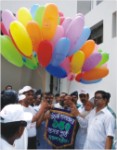 The hospital has a significant historical background. During the long journey from 1858 it has undergone significant periodic changes to accommodate large number of patients and improve its standard to serve the people better. It had started its service with the treatment of simple but prevalent diseases like cholera, diarrhea, fever, anaemia, syphilis and now it has expanded to provide multidisciplinary treatment facilities for other diseases. Cochlear implant surgery was one of the unique surgeries done in this hospital that is only done now in one private specialised hospital. The cardiology department has started notable services including Transradial angiography (an improved method of coronary angiography) on a regular basis. It also has latest diagnostic tools at its disposal to offer services at a low cost. But ironically many patients do not know about the cost-effective services and thereby choose to go to certain private clinics run by the middlemen in the hospitals. The hospital has a significant historical background. During the long journey from 1858 it has undergone significant periodic changes to accommodate large number of patients and improve its standard to serve the people better. It had started its service with the treatment of simple but prevalent diseases like cholera, diarrhea, fever, anaemia, syphilis and now it has expanded to provide multidisciplinary treatment facilities for other diseases. Cochlear implant surgery was one of the unique surgeries done in this hospital that is only done now in one private specialised hospital. The cardiology department has started notable services including Transradial angiography (an improved method of coronary angiography) on a regular basis. It also has latest diagnostic tools at its disposal to offer services at a low cost. But ironically many patients do not know about the cost-effective services and thereby choose to go to certain private clinics run by the middlemen in the hospitals.
The drawback about Sir Salimullah Medical College and Mitford Hospital is its location as it is a congested place and has a grimy environment around it. The murky side of the hospital is in lack of proper maintenance and there is no proper waste disposal system. The hospital authorities haven't yet taken any significant step to keep the hospital spick and span.
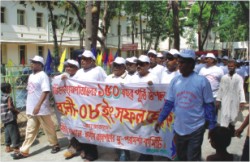 Whatever the condition now, it was once the only center for healthcare of the entire population and a part of our history. According to historiographers, the initiative for building the Mitford Hospital was taken long ago in 1820 by Sir Robert Mitford. He was the Collector of Dhaka and also a long serving judge of the Provincial Court of Appeal. During his time, cholera was an epidemic spreading at an alarming rate. Hundreds of people died per day in Dhaka when it broke out in epidemic form. In those days, medical facilities were found to be very poor and inadequate to fight the scourge. Sir Mitford was shocked to see the meager medical facilities and the sufferings of the people. Before the death of this noble person in 1836, he bequeathed his property to the government of Bengal to build something for the welfare of the marginalised and sick people. Latter, the decision to build a hospital on the property was taken by Lord Dalhousi and his initiative made Robert Mitford's dream become a reality. The total amount of his donated wealth was worth Rs 1, 60,000. Mitford Hospital started its journey with this donation in 1954. Later on some notable people also donated money to build this hospital. Among them Mrs Shontosh Rani Dinmony Chowdhurany, Mr. Roy Sb. Gour Netai Shaha Shonkhonidhy, Mr. Shontosh Raja Monmoth Roy Chowdhury and Babu Protap Chandra Dash bore the expenses of providing drinking water and the sewerage plant of this hospital. Whatever the condition now, it was once the only center for healthcare of the entire population and a part of our history. According to historiographers, the initiative for building the Mitford Hospital was taken long ago in 1820 by Sir Robert Mitford. He was the Collector of Dhaka and also a long serving judge of the Provincial Court of Appeal. During his time, cholera was an epidemic spreading at an alarming rate. Hundreds of people died per day in Dhaka when it broke out in epidemic form. In those days, medical facilities were found to be very poor and inadequate to fight the scourge. Sir Mitford was shocked to see the meager medical facilities and the sufferings of the people. Before the death of this noble person in 1836, he bequeathed his property to the government of Bengal to build something for the welfare of the marginalised and sick people. Latter, the decision to build a hospital on the property was taken by Lord Dalhousi and his initiative made Robert Mitford's dream become a reality. The total amount of his donated wealth was worth Rs 1, 60,000. Mitford Hospital started its journey with this donation in 1954. Later on some notable people also donated money to build this hospital. Among them Mrs Shontosh Rani Dinmony Chowdhurany, Mr. Roy Sb. Gour Netai Shaha Shonkhonidhy, Mr. Shontosh Raja Monmoth Roy Chowdhury and Babu Protap Chandra Dash bore the expenses of providing drinking water and the sewerage plant of this hospital.
After four years of tireless work, the hoispital was finally completed to be inaugurated on 1st May. That day the hospital started with two male and one female ward of total 92 beds.
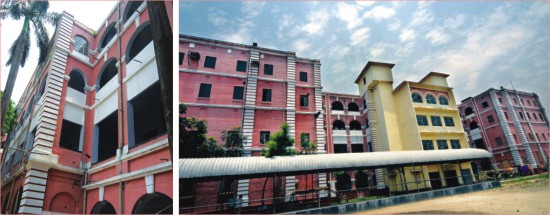
From the inception, the hospital was under the administration of a board accountable to Dhaka Municipality. Another female ward was added to the hospital in 1882 with the generous donations from Nawab Khwaja Ahsanullah of Dhaka and Raja Rajendra Narayan Roy of Bhawal. Nawab Ahsanullah also donated Rs 50,000 to set up Lady Dufferin Hospital within the same compound in 1888-89. An European ward was established in the hospital in 1887, and in 1889-90 Raja Srinath Roy of Bhaggyakul donated money to build an eye ward in memory of his mother. It got the recognition of a first grade hospital in 1917.
The hospital served as the main public hospital in Dhaka city but did not undergo much change in size and infrastructure over a long period of time. Today it occupies an oblong area of about 12.8 acres of land on the bank of River Buriganga. Now it has a number of buildings offering a number of health care services. The main hospital complex is an eight storied building and is well known as a surgery building.
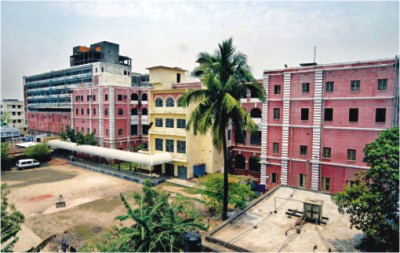
Two other 3-storied annexes include King Edward Building (commonly known as medicine building). The outdoor building is functioning separately. The King Edward building was named after King Edward the VII. Rex Et. Imperator 1901-1910. The relatively new outdoor hospital complex also include Cardiology and Nephrology departments. These annexes were constructed with the donation received from some philanthropists whose names have been carved out on the walls of these buildings.
The hospital serves both indoor and outdoor treatments as well as pathological and diagnostic services. It serves about 2,000 outdoor patients daily. In 1999, the hospital had 600 beds, of which 240 were paying beds. But the number of bed is too little to cope with the huge number of patients. On an average, 680 patients are treated indoor.
A medical school was later set up on the compound attached to the hospital to meet the demand of medical education. During the time, there was no institution in the country to impart medical education. Medical students had to go to far off places to study the subject.
Medical School, the first of its kind in this region began its journey on 15th June, 1875. Later on, the DC of Dhaka division Mr. W.R. Larmini laid the stone of the Academic building on April 1887 and on September 1889 Governor of Bengal Sir Stuart Caulvin presided over the opening ceremony of that building.
The Academic building of Medical School, was then established with the help of near about 16 kings and some others social workers .
A total number of 384 students got admitted in the school in the first batch. The number increased by and by. They got admitted for a four-year course leading to a diploma of LMF (Licentiate of Medical Faculty) offered by the State Medical Faculty.
The LMF course was abandoned in 1957. Medical school was converted to Medical College in 1962 and then it was named "Sir Sallimullah Medical College" (SSMC) after the name of Nawab Sir Salimullah.
 Dr. AFM Nurul Islam took the chair of principal and started the short course of MBBS in 1963. Later, renowned Professor Dr Md Ibrahim took the responsibility of principal and under his direct supervision SSMC started its journey as a Medical College and on 8th February 1973 the first batch of undergraduates started their classes. The Postgraduate course started in January 2002. The 36th batch is studying in this medical college now. Every year 175 new students are given admission. Dr. AFM Nurul Islam took the chair of principal and started the short course of MBBS in 1963. Later, renowned Professor Dr Md Ibrahim took the responsibility of principal and under his direct supervision SSMC started its journey as a Medical College and on 8th February 1973 the first batch of undergraduates started their classes. The Postgraduate course started in January 2002. The 36th batch is studying in this medical college now. Every year 175 new students are given admission.
The college building is four-storied with a floor space of 4940 square meters on each floor. The building accommodates the Department of Anatomy, Physiology, Biochemistry, Pharmacology, Pathology and Microbiology. Department of Community Medicine and Forensic Medicine are housed in other buildings in front of the main building. The clinical Departments namely the Department of Medicine, Surgery, Ophthalmology, Otorhinolaryngology, Orthopedics, Psychiatry, Dermatology, Cardiology, Gynecology and Obstetrics are housed in the Mitford Hospital attached to the college.
The new 8-storied college building is under construction. But the work is progressing very slowly, waiting for the final touches. The present students are not happy doing classes and practical works in the backdated infrastructure and in the shabby academic building. They feel they are deprived of modern institutional facilities and have been urging the authorities concerned to finish the construction work as soon as possible making it fit for academic purpose.
The medical authorities have developed a website, the first of its kind among government medical colleges. For more information regarding the medical college and results of examinations, one can log in to www.ssmc.edu.
The SSMC Alumni Association has taken the initiative to uphold the glory of this noble institution. Students Association and Rotaract club of SSMC have come forward along with the alumni association to preserve the history and archive of the hospital and the college as well. They have a homepage where any former student can log in to register and keep in touch: www.ssmcalumni.org.
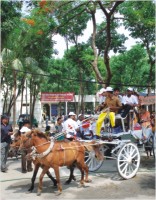 Renowned urban historian Dr Sharif Uddin Ahmed who is also the author of the book 'Mitford Hospital and Dhaka Medical School: History and Heritage, 1858-1947' has told Star Campus about the historical background of the institution. He said that 'Mitford Hospital is not merely a hospital but also a part of our history. It was established with the goal of flourishing medical education in East Bengal and set up an international health research center to provide better healthcare services to our people. But the goal hasn't been fulfilled properly. Particularly the dirty environment of the hospital makes me sad and it should be improved immediately. He urged the authorities concerned to preserve the archeological building infrastructure and ramp up their efforts to make the hospital as an icon of ideal public hospital.' Renowned urban historian Dr Sharif Uddin Ahmed who is also the author of the book 'Mitford Hospital and Dhaka Medical School: History and Heritage, 1858-1947' has told Star Campus about the historical background of the institution. He said that 'Mitford Hospital is not merely a hospital but also a part of our history. It was established with the goal of flourishing medical education in East Bengal and set up an international health research center to provide better healthcare services to our people. But the goal hasn't been fulfilled properly. Particularly the dirty environment of the hospital makes me sad and it should be improved immediately. He urged the authorities concerned to preserve the archeological building infrastructure and ramp up their efforts to make the hospital as an icon of ideal public hospital.'
Professor Dr M Abdullah is the principal of Sir Salimullah Medical College and also the pioneer of Cochlear implant surgery in the country. He expressed his feelings to The Daily Star regarding the hospital and medical college.
“I am glad to be affiliated with SSMC and Mitford Hospital.
This historical institution has been providing healthcare for general population and constantly working to improve the health and quality of their lives for last 150 years”.
Col. Md Shahidul Hoque Mallik has joined the post of director recently. From the time he took charge, the hospital changed considerably in look, discipline and also in improving services like Digital X-ray, MRI, CCU facilities. He shared his thoughts with Star Campus: “Though it has traversed a long way, many needs are left unfulfilled to make it patients-friendly. We need to step up our services, patients care and also have to create proper healthy environment for patients, doctors, nurses and other paramedics. As the chief of the authority, I am really proud to be associated with it.”
Data source:
1. Dr Sharif Uddin Ahmed-'Mitford Hospital and Dhaka Medical School: History and Heritage, 1858-1947
2. Rotaract Club of SSMC
3. Banglapedia
(Md Rajib Hossain is
Reporter, Star Health Page
The Daily Star)
Copyright
(R) thedailystar.net 2008
|

